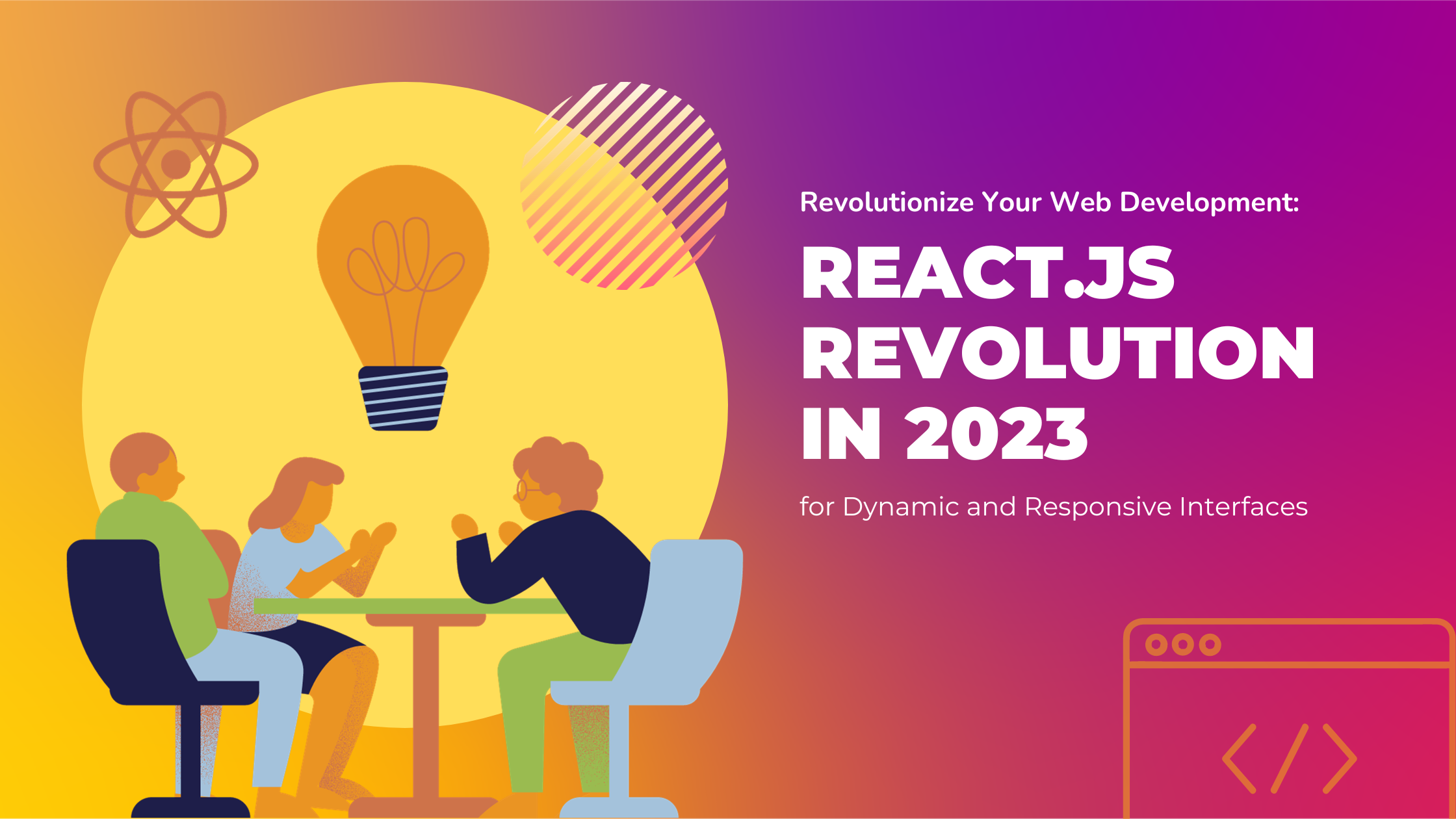🚀 Ready to level up your React.js game? React.js, the popular JavaScript library for building user interfaces, is constantly evolving and taking new directions in 2023. As a fullstack developer, it is essential to understand why React.js is becoming even more essential for web development and why you should consider learning it.
We’re going to explore the evolution of React.js components, get into the nitty-gritty of performance upgrades, and explore what’s essential for Fullstack development.
Ready to turbocharge your coding journey? Let’s go! 🚀
The Rise of React.js in Web Development
React.js has gained immense popularity among web developers since its introduction in 2013. It has revolutionized the way developers build user interfaces, enabling them to create dynamic and interactive web applications. Over the years, React.js has become the go-to library for both large and small companies, dominating the web development market.
According to the State of JS Survey of 2022, React.js emerged as the top choice among developers, with close to 60% of respondents expressing their preference for using React.js again. This overwhelmingly positive feedback demonstrates the consistent popularity and trust developers have in React.js.
1. The Evolution of React.js: Server Components
One of the significant advancements in React.js is the introduction of Server Components. Traditionally, React.js has been primarily focused on client-side rendering, where components live within the client app. However, with React 18, developers can now build apps that move logic over to the server using Server Components.
Server Components offer a new approach to building web applications by enabling server-side rendering or a combination of server and client-side rendering. This feature allows for improved performance and scalability, making React.js an even more powerful tool for fullstack developers.
// ServerComponentExample.js
import React, { ServerComponent, useState } from 'react';
// Define a simple server component
const ServerCounterComponent = ServerComponent(() => {
const [count, setCount] = useState(0);
const increment = () => setCount(count + 1);
return (
<div>
<h2>Server-side Counter</h2>
<p>Count: {count}</p>
<button onClick={increment}>Increment</button>
</div>
);
});
// Client-side component that uses the server component
const App = () => {
return (
<div>
<h1>React 18 Server Components Demo</h1>
<ServerCounterComponent />
<p>Client-side content rendering alongside the server component!</p>
</div>
);
};
export default App;2. Improved Performance with Concurrent Mode
In 2023, React.js introduces Concurrent Mode, which brings significant performance improvements to complex and computationally intensive applications. Concurrent Mode allows React.js to work on multiple tasks simultaneously, breaking them into smaller units of work known as “fibers.” This approach ensures that applications remain responsive even during expensive calculations, network requests, or rendering large component trees.
With Concurrent Mode, React.js minimizes the frequency of costly DOM operations needed to refresh the UI, resulting in faster and more efficient web applications. This feature is particularly beneficial for fullstack developers working on projects that require high-performance and responsiveness.
import React, { useState, useEffect, unstable_ConcurrentMode as ConcurrentMode } from 'react';
const ExpensiveCalculationComponent = () => {
// Simulating a computationally intensive task
const performExpensiveCalculation = () => {
let result = 0;
for (let i = 0; i < 100000000; i++) {
result += i;
}
return result;
};
const [calculationResult, setCalculationResult] = useState(null);
useEffect(() => {
// Concurrent Mode enables asynchronous rendering
setCalculationResult(performExpensiveCalculation());
}, []); // Empty dependency array ensures the effect runs only once
return <div>{calculationResult !== null ? `Result: ${calculationResult}` : 'Calculating...'}</div>;
};
const App = () => {
return (
<ConcurrentMode>
<div>
<h1>React Concurrent Mode Example</h1>
<ExpensiveCalculationComponent />
</div>
</ConcurrentMode>
);
};
export default App;Why React.js is Essential for Fullstack Developers
As a fullstack developer, React.js offers several key advantages that make it essential for your web development toolkit. Let’s explore these advantages in detail:
1. Easy to Learn and Quick to Develop
One of the primary reasons why React.js is widely adopted is its ease of learning and quick development process. React.js follows a component-based architecture, allowing developers to break down their apps into reusable and independent components. This modular approach simplifies development and makes it easier to understand and maintain code.
Additionally, React.js leverages JavaScript, a language that most web developers are already familiar with. This familiarity with JavaScript makes it easier for fullstack developers to transition into React.js and start building applications quickly.
2. Efficient Code Reuse
React.js’s component-based architecture promotes code reusability, allowing developers to create modular and reusable components. This feature significantly accelerates development time and reduces code duplication.
By leveraging existing components and libraries, fullstack developers can build new features without starting from scratch. This efficiency in code reuse not only saves time but also improves the maintainability and scalability of web applications.
3. Vast Ecosystem and Community Support
React.js has a thriving ecosystem with a wide range of tools, libraries, and frameworks that enhance its functionality and simplify development processes. The React.js ecosystem offers solutions for routing, state management, server-side rendering, and much more.
React Router is a popular choice for handling complex routing logic in React.js applications. It provides a declarative way to define routes and render different components based on the current URL.
Redux Toolkit is a powerful state management library for React.js that simplifies the management of complex application state. It provides a set of tools and best practices for efficiently managing state and includes features such as immutable updates and built-in support for asynchronous logic.
React Query and SWR are two libraries that focus on server state management. They provide convenient ways to handle data fetching, caching, and synchronization with server-side APIs.
These are just a few examples of the vast ecosystem and community support that React.js offers. The strong community behind React.js ensures that developers have access to resources, tutorials, and support when building their applications.
4. Cross-Platform Development with React Native
React.js’s sibling framework, React Native, enables fullstack developers to build native mobile applications for iOS and Android using the same codebase. This cross-platform capability allows for efficient development and deployment of mobile applications, reducing the need for separate development teams for each platform.
By leveraging their existing React.js knowledge, fullstack developers can easily transition into mobile app development using React Native. This seamless integration between web and mobile development saves time and effort, making React.js an ideal choice for fullstack developers.
5. SEO-Friendly Web Development
In the realm of web development, search engine optimization (SEO) plays a crucial role in driving organic traffic to websites. React.js is SEO-friendly, as it renders components on the server before sending them to the client.
This server-side rendering (SSR) approach ensures that search engines can crawl and index web pages effectively, leading to better visibility and higher rankings in search results. By adopting React.js, fullstack developers can build web applications that are not only visually appealing but also optimized for search engines.
The Future of React.js and Fullstack Development
As we embark on a new year, the future of React.js and fullstack development looks promising. React.js continues to evolve, introducing new features and improvements that enhance the development experience for fullstack developers.
The release of Concurrent Mode and Server Components demonstrates React.js’s commitment to performance and scalability. These advancements enable developers to build high-performance web applications that seamlessly integrate server and client-side rendering.
Furthermore, React.js’s vast ecosystem and community support ensure that fullstack developers have access to the latest tools, libraries, and best practices. This thriving community fosters collaboration and knowledge-sharing, enabling fullstack developers to stay up-to-date with the latest trends and advancements in React.js.
In conclusion, React.js is taking a new direction in 2023, becoming even more essential for fullstack developers. With its ease of learning, efficient code reuse, vast ecosystem, cross-platform capabilities, and SEO-friendliness, React.js empowers fullstack developers to build powerful and dynamic web applications. By embracing React.js, fullstack developers can stay at the forefront of web development and deliver exceptional user experiences.
Happy learning!






